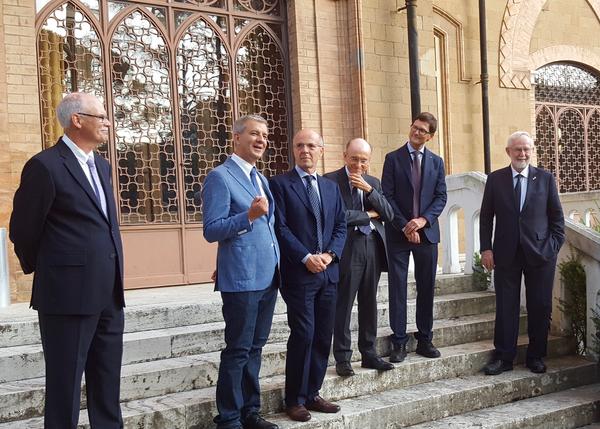Formation of the Global Argon Dark Matter Collaboration

On Sept. 8, 2017 an information session was held at the Canadian Embassy in Rome to announce the formation of the Global Argon Dark Matter Collaboration, including members from the Darkside-50, DEAP-3600, ARDM and MiniClean collaborations. The membership totals 350 scientists from 68 institutions in 12 countries and has an immediate objective of a 20,000 kilogram detector called DarkSide-20k to be sited at the Gran Sasso Laboratory in Italy, using argon from an underground source in Colorado, USA, with further removal of the isotope 39Ar at a cryogenic distillation column in Sardinia. The overall objective is a reduction of 39Ar content by a factor of more than 15,000 with a high throughput, which will enable a low-background search for the mysterious dark matter, known to account for most of the matter in the universe, but not yet directly observed. A longer term objective of the collaboration is the creation of a detector with 300,000 kg or more low-radioactivity argon at a future site and technology to be determined. This detector will have the capability of reaching to the so-called “Neutrino floor” created by coherent atmospheric neutrino scattering and will have excellent ability to reject low-energy pp solar neutrino events, through the strong electron discrimination capability of liquid argon, providing unambiguous selection of nuclear recoils from weakly interacting massive dark matter candidates. At the same time, it will also have the ability to perform very precise measurements of higher-energy solar neutrinos such as 7Be, pep, and CNO neutrinos.
The event on September 8 included an overview by Nobel Physics Laureate Art McDonald who is a collaboration member, together with presentations by DEAP-3600 Director Professor Mark Boulay of Carleton University, Canada, Darkside-50 and -20k Director Professor Cristiano Galbiati of Princeton University, USA, and by the Directors of the Laboratories associated with the projects, Dr. Nigel Smith of SNOLAB, Dr. Aldo Ianni of Laboratorio Subterráneo de Canfranc (LSC) and Prof. Stefano Ragazzi of Laboratori Nazionali del Gran Sasso (LNGS), who also provided a joint letter of support for the collaboration. These presentations were followed by a Panel Discussion moderated by Dr. McDonald and including Dr. Stavros Katsanevas, Director of the Laboratoire Astroparticle et Cosmologie (APC) and former Chair of the Astroparticle Physics European Consortium (APPEC), Dr. Jim Whitmore of the US National Science Foundation (NSF) and Prof. Fernando Ferroni, President of the Italian Istituto Nazionale di Fisica Nucleare (INFN), on the value of international cooperation among scientists and laboratories in the field of Particle Astrophysics. The event was attended by Collaboration scientists and funding agency representatives from a number of the countries involved. The information session was followed by a reception sponsored by SNOLAB and Queen’s University, Canada at which final remarks were provided by Dr. John Fisher, VP Research of Queen’s University, Prof. Antonio Masiero, Vice President of INFN and current Chair of APPEC and Paul Gibbard, Charge d’Affaires of the Canadian Embassy.
Equipment for the first third of the cryogenic distillation column has undergone testing at CERN and is expected to begin installation later this year. Detailed design for the Darkside-20k detector is complete, positive response has been obtained for part of the international funding requests and decisions on others are expected in the near future.
For more information, please contact:
Cristiano Galbiati
Professor of Physics, Princeton University
galbiati@Princeton.EDU
P: (609)258-1245